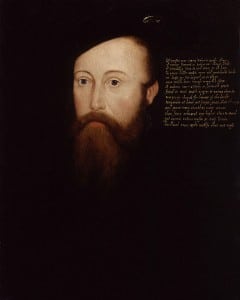 On this day in 1549 Thomas Seymour, 1st Baron of Sudeley, Lord High Admiral and the fourth husband of the late Dowager Queen Catherine Parr, was executed on Tower Hill. He had been found guilty of thirty-three counts of treason following his arrest at Hampton Court Palace when he had allegedly broken into his nephew Edward VI’s apartments to kidnap him.
On this day in 1549 Thomas Seymour, 1st Baron of Sudeley, Lord High Admiral and the fourth husband of the late Dowager Queen Catherine Parr, was executed on Tower Hill. He had been found guilty of thirty-three counts of treason following his arrest at Hampton Court Palace when he had allegedly broken into his nephew Edward VI’s apartments to kidnap him.
In Sir John Harington’s Nugae Antiquae collection of orginal papers, in prose and verse appears the following poem said to have been written by Seymour a week before he was beheaded:
Forgetting God to love a king
Hath been my rod, or else nothy’nge
In this frail lyfe being a blaste
Of care and stryfe, til yt be paste.
Yet God did call me in my pryde
Leste I shulde fall and from him slyde.
For whom he loves he muste correcte,
That they may be of his electe.
Then death haste thee, thou shalt me gaine
Immortallie with God to raigne!
Lord! sende the Kinge like years as Noye [Noah],
In governinge this realme in joye;
And, after thys frayl lyfe, such grace,
That in thy blisse he maie find place.1
Harington then goes on to describe Seymour as “an aspiring man” who was “said to have been an excellent master to those knights and gentry who served under him.”
You can read more about Thomas Seymour in the following articles:
I have written many articles on Thomas Seymour so do check them out:-
- 16 January 1549 – Thomas Seymour, the Young King and the Spaniel
- Thomas Seymour’s Execution 20 March 1549
- The Execution of Thomas Seymour – Gives more detail on his downfall.
- Thomas Seymour Breaks into the King’s Residence
- Catherine Parr and Thomas Seymour Part One
- Catherine Parr and Thomas Seymour Part Two
- Elizabeth, Seymour and Shakespeare
Notes and Sources
- Harington, Sir John. (1804) Nugae antiquae, being a miscellaneous collection of original papers, in prose and verse; written during the reigns of Henry VIII. Edward VI. Queen Mary, Elizabeth, and King James, London, Vernor and Hood.
Very sad for a young intelligent man to have such a tragic end. He was very ambitious and was willing to do any thing for power. The saddest part was that his nephew Edward vi signed the death warrant and their those that say king Edward was weak. It is unfair that Edward Seymour is portrayed as the wicked brother, i was surprised to read that he tried to protect thomas and even hesitated.
“This day died a man of much wit and very little judgment…”
I adore Tom Seymour in YOUNG BESS, both book and movie…but in real life? He KILLED A SPANIEL. Sorry, that does it for me — he’s not getting anywhere near MY spaniels!
Hi India,
Elizabeth’s remark sums the man up completely doesn’t it.
He knew what he wanted, but was a bit over zealous in how he went about getting it, a loose cannon really. I am surprized he lasted as long as he did…
I’ve got a looney spaniel too, Jake, or Jacob when he’s in bad books 🙂
sorry but dont like the sound of this man at all.
I did like in the novel Young Bess how he tells Harrington that in 100 years they’ll be executing their king, and Harrington does the math and says, “That’ll be 1649.” Such fun you can have writing historical fiction!
As for Seymour himself, I rather suspect he was as ambitious and venal as he is often portrayed, but probably no more so than most of his peers. Unfortunately for him, he was also less subtle and thus was caught. The attempted kidnapping of King Edward was the last straw (and, yes, killing the spaniel did not sweeten young Edward towards him when it came time to sign the warrant).
Elizabeth’s comment as quoted by India is a fair epitaph. Especially the “very little judgement.”
I am currently reading the book Mary and Elizabeth by Emily Purdy that talks about the childhoods and such of Elizabeth I and Mary I. In it, there is mention of Thomas Seymour trying to woo Mary by pretending to be the ‘Cakes and Ale Man’ and even sneaks into her bedroom to hide cakes there. I was wondering if anyone knew if there was any fact in this or evidence that this really happened? On a side note, I’m visiting the Tower of London in two days, so hopefully I’ll be able to visit where he was executed, as well as Anne Boleyn’s grave site, where I’ll be placing flowers.
Anne buried under the floor in the chapel. Not marked when i was there. The green area has a big marker on the site where royal executions occurred
Anne Boleyn’s grave has been marked since 1877. There is a beautiful memorial tile marking the spot and it says “Queen Anne Boleyn”.